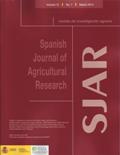View Item
- xmlui.general.dspace_homeCentros Regionales y EEAsCentro Regional Buenos Aires NorteEEA PergaminoArtículos científicosxmlui.ArtifactBrowser.ItemViewer.trail
- DSpace Home
- Centros Regionales y EEAs
- Centro Regional Buenos Aires Norte
- EEA Pergamino
- Artículos científicos
- View Item
Soil microbial functionality in response to the inclusion of cover crop mixtures in agricultural systems
Abstract
Agricultural systems where monoculture prevails are characterized by fertility losses and reduced contribution to ecosystem services. Including cover crops (CC) as part of an agricultural system is a promising choice in sustainable intensification of those demanding systems. We evaluated soil microbial functionality in cash crops in response to the inclusion of CC by analyzing soil microbial functions at two different periods of the agricultural year
[ver mas...]
Agricultural systems where monoculture prevails are characterized by fertility losses and reduced contribution to ecosystem services. Including cover crops (CC) as part of an agricultural system is a promising choice in sustainable intensification of those demanding systems. We evaluated soil microbial functionality in cash crops in response to the inclusion of CC by analyzing soil microbial functions at two different periods of the agricultural year (cash crop harvest and CC desiccation) during 2013 and 2014.
Three plant species were used as CC: oat (Avena sativa L.), vetch (Vicia sativa L.) and radish (Raphanus sativus L.) which were sown in two different mixtures of species: oat and radish mix (CC1) and oat, radish and vetch mix (CC2), with soybean monoculture and soybean/corn being the cash crops. The study of community level physiological profiles showed statistical differences in respiration of specific C sources indicating an improvement of catabolic diversity in CC treatments. Soil enzyme activities were also increased with the inclusion of CC mixtures, with values of dehydrogenase activity and fluorescein diacetate hydrolysis up to 38.1% and 35.3% higher than those of the control treatment, respectively. This research evidenced that CC inclusion promotes soil biological quality through a contribution of soil organic carbon, improving the sustainability of agrosystems. The use of a CC mixture of three plant species including the legume vetch increased soil biological processes and catabolic diversity, with no adverse effects on cash crop grain yield.
[Cerrar]

Author
Fuente
Spanish Journal of Agricultural Research
14 (2) : e0304
Date
2016
ISSN
2171-9292
Formato
pdf
Tipo de documento
article
Palabras Claves
Derechos de acceso
Abierto
 Excepto donde se diga explicitamente, este item se publica bajo la siguiente descripción: Creative Commons Attribution-NonCommercial-ShareAlike 2.5 Unported (CC BY-NC-SA 2.5)
Excepto donde se diga explicitamente, este item se publica bajo la siguiente descripción: Creative Commons Attribution-NonCommercial-ShareAlike 2.5 Unported (CC BY-NC-SA 2.5)


